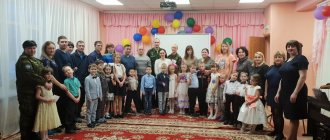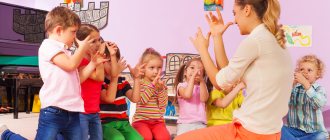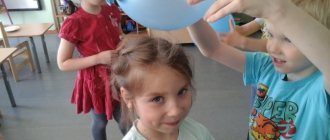Project activities in working with families
The priority function of cooperation between a preschool institution and a family is to introduce parents to the normative components of preschool education, informing them about the tasks, content and methods of education in kindergarten. Advanced teaching practitioners reinforce the concept of “collaboration” with parents with the concept of “interaction” as a category reflecting the processes of the influence of objects on each other, mutual conditioning and generation of one object by another.
Interaction is a universal form of movement and development that determines the existence and structural organization of any material system.
It seems that one of the methods of active learning - the project method - can be considered an effective form of increasing the educational culture of parents and modernizing the information and educational function of cooperation.
A feature of project activities in the preschool education system is that the child cannot yet independently find contradictions in the environment, formulate a problem, or determine a goal (intention). Therefore, in the educational process of a preschool educational institution, project activities are in the nature of cooperation, in which children and teachers of the preschool educational institution take part, and parents and other family members are also involved on a voluntary basis.
Modern researchers - psychologists (V.P. Bederzhanova, O.S. Gazman, V.G. Maralov, V.A. Sitarov) Fr.
As the tasks are solved, a competent adult helps the child find the necessary means and methods for this, and often introduces children to new things that are not yet known to him.
Relying on the help of adults, children seek a solution to the problem through questions to their parents, joint trips to the library, reading children's educational and reference publications; trips, hikes; observations and excursions, classes in hobby groups and studios. Together with their parents, they are engaged in productive activities: collecting collections, designing family albums, drawing, sculpting, sewing, crafting, cooking, experimenting, inventing and composing. At the same time, it is very important that adults do not do anything for children and do not interfere with their ability to demonstrate maximum abilities, independence, initiative and creativity. As a rule, the topic of projects becomes a specific section of the educational program. But if it arose on the initiative of the children themselves, it is very valuable and must definitely find support from adults.
The objectives of teaching project activities are different for each age of preschoolers. For example, teachers L.S. Kiseleva, G.S. Lagoda and M.B. Zuykova in primary preschool age defines them as:
- children’s entry into problem and play situations (the leading role of an adult);
— activation of looking for ways to resolve a problematic situation (together with an adult);
— formation of initial prerequisites for research activities (practical experience).
In older preschool age this is:
— formation of prerequisites for search activity and intellectual initiative;
- developing the ability to determine possible methods of solving a problem with the help of an adult, and then independently;
— developing the ability to use these methods to help solve problems;
— developing a desire to use special terminology, conducting a constructive conversation in the process of joint research activities.
Parents can be given varying degrees of participation in the project: leader, participation at all or individual stages; consultant, logistical support, etc.
Festivals, exhibitions and family design competitions are becoming traditional.
Family design is a step towards increasing the competence of parents and the possibility of productive interaction between adults and children.
Approximate distribution of joint design actions of parents and children at the design stages.
| Design stages | Parents' actions | Children's activities |
| Preparatory | Formulate problems, determine topics, goals (why) and deadlines. They plan upcoming activities and determine means. | They take part in discussing the problem, the plan for future work, and determining means of implementation. |
| Analytical | They conduct a joint search for information in the literature, the Internet, and seek help from specialists. They analyze, discuss, and offer a choice of an analogue model. They draw up an algorithm of actions, distribute responsibilities and assignments. | Organize a joint search for information. They ask adults questions and look for answers on their own. They defend their positions in the discussion, accept instructions, and negotiate with other design participants. |
| Basic | They involve children in achieving the intended plan according to a pre-developed algorithm. They carry out basic joint activities (excursion, going to the library, reading literature, learning, examining, comparing, agreeing, experimenting, purchasing, designing, making, conversations, discussions, etc.). They prepare surprises and prizes secretly from others. Conduct joint and individual rehearsals. | Participate in excursions, going to the library, reading literature, conversations, discussions. They prepare surprises and ask for help when it is impossible to do anything on their own. |
| Presentation | Within the stipulated period, they participate in the presentation (by project participants and guests) of the product of the project activity. | Along with adults, they participate in the presentation (by project participants and guests) of the product of project activity on an equal basis. |
| reflective | They ask questions: What happened? Did you get what you wanted? Did we learn anything new? What surprised and pleased us? What did we like most? What should you change next time? | They answer and ask questions. The topics for the next projects are outlined. |
Project development algorithm (according to E.S. Evdokimova)
| Stages | Tasks | Activities of the project group | Activities of the scientific and methodological service |
| Elementary | Definition of the problem (topic). Selecting a group of participants. | Clarification of available information, discussion of the task. | Motivation for design, explanation of the purpose of the project. |
| Planning | Problem analysis. Identification of information sources. Setting objectives and choosing criteria for evaluating results. Distribution of roles in the team. | Formation of tasks, accumulation of information. Selection and justification of success criteria. | Assistance in analysis and synthesis (at the request of the group). Observation. |
| Decision-making | Collection and clarification of information. Discussion of alternatives. Choosing the optimal option. Clarification of activity plans. | Working with information. Synthesis and analysis of ideas. | Observation, consultations. |
| Performance | Project implementation. | Work on the project, its design. | Observation, advice (at the request of the group). |
| Evaluation of results | Analysis of project implementation and achieved results (successes and failures). | Participation in collective project analysis and self-assessment. | Observation. Direction of the analysis process (if it is needed). |
| Project protection | Preparation for defense. Rationale for the design process. Explanation of the results obtained, their evaluation. | Project protection. Participation in collective assessment of project results. | Participation in collective analysis and evaluation of project results. |
Mastering project activities by preschool children.
| Design stage activities | Age | ||
| 4-5 years | 5-6 years | 6-7 years | |
| Preparatory | An integrative beginning that meets the needs of children. Identification of problems to adults. | Identification (by an adult or a child) of an issue that meets the needs of both parties. | Identification of an issue (by children or adults) that meets the needs of the children or both. |
| Goal setting | Determination by adults of the purpose of the project, its motivation. | Joint determination of the project goal and upcoming activities. Predicting the result. | Children independently determine the goal of the project and the motive for the upcoming activity. Predicting the result. |
| Planning | Involving children in planning activities and implementing the plan. | Planning activities by children with little help from adults, determining means and ways to implement the project. | Planning activities by children (with the possible participation of an adult as a partner), determining the means of implementing the project. |
| Performing | The joint movement of adults and children towards the result: “doing together according to the model”, carrying out individual simple tasks. | Children's implementation of the project, differentiated assistance from adults. | Children’s implementation of a project, creative disputes, reaching an agreement, mutual learning, mutual assistance. |
| Presentation | Presentation of the product of project activities. | Presentation of the product of project activities. | Presentation of the product of project activities. |
| reflective | Joint analysis of the project implementation, comprehension of the result. | Discussion of the result, progress of work, everyone’s actions, finding out the reasons for successes and failures. | Discussion of the results of the progress of work, everyone’s actions, finding out the reasons for successes and failures. |
| Design | Determine design prospects together with children. | Determining the prospects for the development of design. | |
Used Books:
1. L.D. Morozov "Pedagogical design in preschool educational institutions: from theory to practice." Publishing house "Creative Center Sphere" - Moscow, 2010.
2. A.A. Mayer, O.I. Davydov “555 ideas for involving parents in the life of a kindergarten.” Publishing house "Creative Center Sphere" - Moscow, 2011.
3. V.S. Gainullova, E.M. Zotov “Kindergarten and School of the Future: the basics of cooperation and partnership.” Publishing house "Creative Center Sphere" - Moscow, 2011.
Academician D.S. Likhachev once wrote that love for one’s native land, one’s country begins with love for family. And today we must restore our ancient values of caring for family and home. The family influences the child and introduces him to society. We, adults, must help children understand the importance of family, cultivate love and respect for its members, and instill a sense of attachment to home. Unfortunately, in many modern families too little attention is paid to raising children.
The interaction of parents and teachers in the upbringing of preschool children is the mutual activity of responsible adults. It is obvious that the old forms of contact with parents are gradually becoming obsolete. Modern parents, first of all, demand respect for themselves; they are literate, informed, but at the same time very busy. Therefore, they do not want any unnecessary information. Parents' employment is the main problem in the interaction between kindergarten and family. Thus, there is a need to find new approaches to organizing work on the interaction of a preschool educational institution and the families of pupils.
In the practice of modern educational organizations, only traditional forms of work to interact with families are often used, such as: consultations, exhibitions, parent meetings, and, most rarely, conferences, open days, which are held irregularly, and the topic does not always coincide with the content. Parents do not actively participate in such events. Innovative approaches to interaction with the families of pupils are needed, since the use of various forms of work with the parents of pupils helps parents become active participants in the educational process, from “spectators” and “observers” to become active assistants to the teacher.
In order for parents to become interested in the life of the kindergarten and become active participants in the educational process, it is advisable to use one of the unique and effective forms of interaction between the preschool educational institution and the family - project activities. This unique tool not only ensures co-creativity between children and adults, but also ensures cooperation and mutual assistance between teachers and parents. It is a means of integrating preschool educational institutions and families.
The project method is a pedagogical technology, the core of which is the independent activity of children - research, cognitive, productive, during which the child learns about the world around him and embodies new knowledge into real products. The essence of the “project method” in education is such an organization of the educational process in which students acquire knowledge and skills, experience in creative activity, an emotional and value-based attitude to reality in the process of planning and performing gradually more complex practical tasks of projects that have not only cognitive, but also pragmatic value. “Everything I learn, I know, why I need it and where, and how I can apply this knowledge” - this is the main thesis of the modern understanding of the project method, which attracts many educational systems seeking to find a reasonable balance between academic knowledge and pragmatic skills.
The project method is based on the idea of focusing the cognitive activity of preschoolers on the result that is achieved in the process of joint work between the teacher and children on a specific practical problem (topic).
In kindergarten, projects can only be for children and adults. Children, parents, teachers, and preschool specialists take part in such projects. This form is interesting because the joint collection and production of attributes, games, competitions, and presentations reveal the creative potential of children and attract parents to participate.
During the implementation of the project, interaction and creative collaboration occur between parents and children. The atmosphere of fun and games allows you to throw off the shackles of self-control and show your best side. By getting to know their loved ones better, children and parents become closer to each other, which naturally affects the results of their activities.
The foundations of project activities were laid at the beginning of the twentieth century in the pedagogical works of D. Dewey, W.H. Kilpatrick, E. Collings and others. At the same time, domestic innovative teachers S. T. Shatskiy, V. N. Shulgin, M. V. Krupenina, V. V. Ignatiev and others. The authors studied the conditions and methods of introducing and applying project activities in the practice of working with preschool children. In 2000, the active use of project activities began in domestic preschool educational organizations. The teachers believed that project activities could ensure intensive development of creative initiative and independence in children’s learning and would establish a connection between theory and practice.
Veraksa N. E. identifies three main types of project activities: creative, research and normative, each of them has its own characteristics, structure and characteristic stages of implementation. In practice, preschool educational institutions often plan and organize research and creative projects.
Project activities are aimed not only at developing the child’s personality, but also at developing his creative and cognitive abilities, the ability to plan and navigate the information space, work in a team, and carry out the process of learning the necessary information, which should be supported by the real result of the work. N. E. Veraksa said: “project activity has a pronounced coloring and ultimately becomes one of the few socially significant actions available to a preschooler.”
Another feature of this method is that it is targeted, both in the process of interaction and in the final result. Project activity can be represented as a way of organizing the learning process, based on the interaction of the teacher, student and his parents, in step-by-step practically significant activities. The child gains knowledge and skills in the process of careful planning and implementation of gradually more complex practical exercises (projects) and achieves his goal together with the teacher and parents.
In the process of project activities, various tasks are solved: educational, creative, psychological, educational, since they can have different topics and content. Children's knowledge about the world around them expands. In addition, children’s general abilities – cognitive, communicative and regular – develop. A variety of play activities also develops, children’s friendly relationships are formed and strengthened, they become more attentive to each other, and begin to be guided not only by their own opinions, but also by established norms. Thus, the child acquires the qualities of a socially competent person.
Child-parent relationships develop and improve through the joint implementation of a plan. Parents develop an analytical view of the practice of raising and educating children. The position of parents and educators will become more flexible. Children become interesting to parents as partners in joint activities. Now they are not spectators and observers, but active participants in various events. Fathers and mothers feel more competent in raising children. This involves carrying out research and creative projects. Involving parents in joint project activities gives them the opportunity to gain new experience in modeling their own parental behavior, enrich their teaching experience, and discover unknown sides of their own child’s personality.
Project activities also have a huge impact on the teacher. Design forces the teacher to constantly be in the space of possibilities, which changes the worldview and excludes the use of standard actions, requiring personal and creative growth. In this situation, the teacher becomes an attractive communication partner. The teacher designs, plans a system of influences on the child, and predicts the result. The interest of parents in achieving their goals serves as a real help to the teacher. Interaction and cooperation of parenting adults has a positive effect on the all-round development of the child.
With the help of project activities, you can reach a new level of interaction with the family of pupils, change the relationship in the “children - parents - teacher” system. Parents will begin to see teachers as their assistants in education and training, and the kindergarten will become a partner for them. Thanks to this, an atmosphere of mutual respect and understanding of each other is created.
Thus, project activity is an optimal, innovative and promising method. The introduction of project activities into the practice of preschool educational institutions will significantly increase the independence and activity of children, develop their creative and analytical thinking, the ability to find interesting information about a subject or phenomenon and use the acquired knowledge in reproducing new projects. Based on a personality-oriented approach to teaching and upbringing, project activities should ultimately contribute to the personal development of the child.
Adults, in turn, need to help the child discover a problem or provoke its emergence, awaken interest in it and lure children into a joint project. Child-parent pedagogical projects will contribute to the establishment of partnerships with the child’s family and will help in solving pressing problems in the upbringing and education of children in the community of parents and teachers. The attitude of parents will change, both towards the teacher and towards the preschool educational organization as a whole, which in turn will ensure high-quality results of teaching activities.





